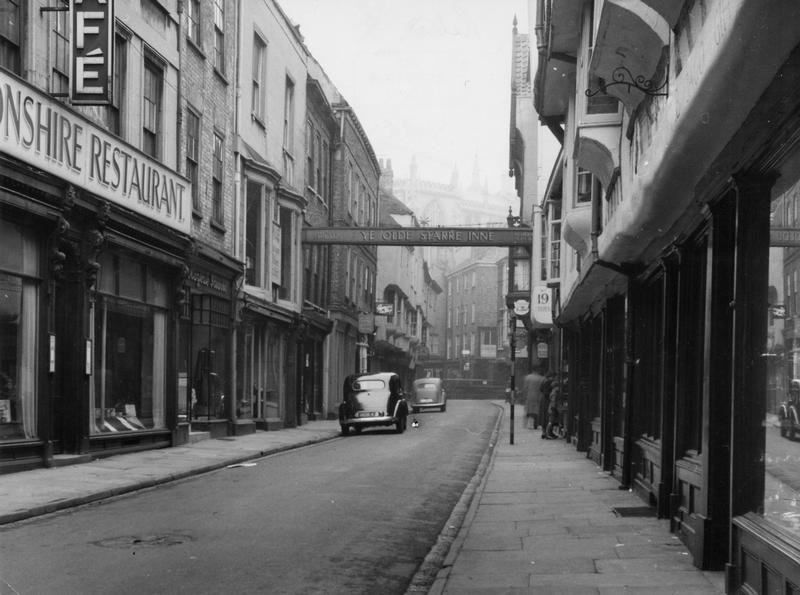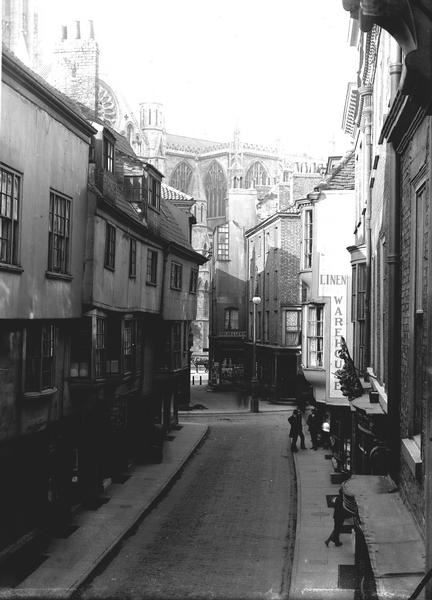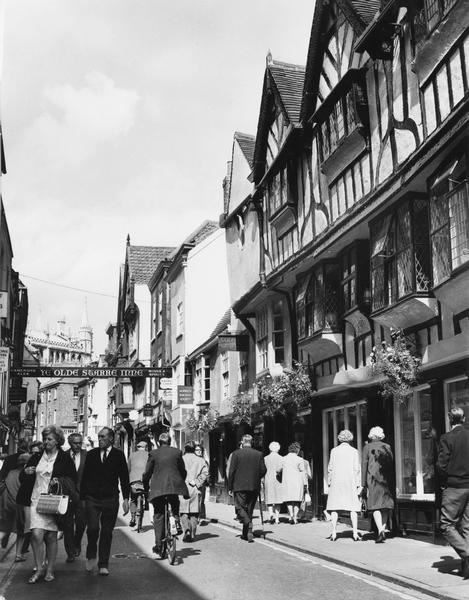
Stonegate in the 1940s/50s. Photo: Explore York Libraries and Archives
In recent days there has been angry reaction to the rather patchy state of the paving in Stonegate, and a petition has been set up. It’s reminding me, in some respects, of another paving-related controversy in 2013.
Then, as is so often the case, it was enlightening and interesting to look back at images from the archives. So I thought we could do that again, with some images of Stonegate, in times past. They’re all from the online collection at Explore York Libraries and Archives.
Specifically, I’m trying to draw attention to the changes in the surface of the street.
It looks rather ‘earthy’ and cobbley in the late nineteenth century. By the mid twentieth century the road surface appears to be tarmac/asphalt.
Many of the comments on the petition and elsewhere online regarding the removal of slabs (broken, apparently, and so needing to be replaced) make it clear that some people are upset, outraged even, at what is seen as our history being destroyed. I don’t like to see people being upset and outraged, so let’s stand back and calmly consider the issue.
Here’s another photo of Stonegate, in the late nineteenth century:

Stonegate, 1880s (Photo: Explore York Libraries and Archives)
And another, from 1904:

Stonegate, 1904. (Photo: Explore York Libraries and Archives)
Another from the mid twentieth-century:

Stonegate, 1940s/50s (Photo: Explore York Libraries and Archives)
And one from a little later, early 1970s perhaps?

Stonegate, early 1970s? (Photo: Explore York Libraries and Archives)
No stone slabs across the roadway, from the 1880s to as late as the 1970s, according to this photographic evidence.
Fact is, these stone slabs in Stonegate are a relatively recent addition. Some sources say that they date from the 1970s, others the 1980s.
Clearly the actual stone, being natural stone, is in itself old and venerable, but its arrangement here as a surface for the roadway is quite recent history. As was the case with the cobbles and cart tracks in Kings Square.
Though a relatively recent addition the stone slabs are clearly accepted as somehow fitting with what we think a street called Stonegate should look like. But let’s not assume that there’s something historically accurate and ‘authentic’ about it.
‘York stone’ is a widely accepted term we tend to use without thinking about it. I know I have. We tend to use the word to refer to any natural stone in slabs. In this particular paving controversy the name seems to have been taken as a sign that this stone somehow ‘belongs’ to York, as if there’s a quarry for it somewhere in the city or its outskirts.
The Stonegate slabs are apparently English Pennine sandstone, so they’re coming from some distance away. And they’re very expensive. And, according to the Streetscape Strategy not the best road surface:
Streets with stone setts and cobbles should be conserved and maintained. The exception is Stonegate, unusually surfaced in riven English Pennine sandstone flags in the 1970s. As a carriageway material this has proved to be a dramatic failure and requires expensive and continual maintenance due to the impact of heavy delivery traffic.
Source (PDF)
I guess what we’re seeing at present is part of that ‘expensive and continual maintenance’. In a footnote it continues:
There will be challenges to this view because there is a perception that the stone flags are an authentic expression of the streets historic roots
Discussion of authenticity and history is one thing, but the bottom line is that just now it looks a mess. Despite the council apparently having a strategy for the streetscape it doesn’t seem to have worked well in this case, does it. When I first saw photos online I thought the patching was just in one area, but there are blobby bits of black patching all the way along, as I realised when I walked along Stonegate yesterday.
Perhaps some warning might have helped, a council press release explaining what they’ve attempted to explain since. Seems odd that anyone could think that so many slabs could be removed and patched in such a central and important street without people noticing.
And, like I said, it brings back bad memories of the time the council’s paving work close to another much-loved York street brought us to the attention of the Daily Mail, and much angry and outraged tweeting followed, with councillors and council staff then having to deal with the flak. I remember spending much of that Friday evening writing this page about it — one of my most-visited.
Meanwhile, beyond the touristy bits, old stones and irreplaceable stable paviours are often lifted and lost, or covered with tarmac/asphalt, and barely anyone notices or cares. If someone started a petition or campaign to protect the hexagonal loveliness of some of the city’s back alleys I’d sign that, but as far as Stonegate goes, I’m sure the council will reinstate it all pretty sharpish, and no doubt spend a lot of money doing so.
More information/update (16 May)
In response to some queries and discussion on Twitter, I’ve done a bit more research.
According to Patrick Nuttgens in York: the continuing city Stonegate was paved in 1975, after being pedestrianised in 1971. As the book was first published in 1976 I guess we can assume that this date is accurate. (I have the later edition, 1989, which includes a photo of Stonegate with its slabs.)
My earlier piece on the Stonegate Arcade included a link to an article about Eric Pearson, former City Planning Officer. It says: ‘Mr Pearson masterminded the scheme to make Stonegate a pedestrianised area. His policy included using second-hand paving stones and creating characteristic entrances to highlight adjoining streets.’
. . . . .
If you’re interested in York’s paving, old and new, there are many pages on this site on the subject. See the related pages links below or try this link.





I grew up on Telford Terrace where we had stone flags up til the 70s when they were taken up and replaced by concrete paving. Word then was that the old flags were destined for the city centre. A keen roller skater at the time, I was delighted with the smooth uniformity of the new surface! I suspect the pennine sandstone on Stonegate originated from the suburbs, rather than further afield.
Ah yes, roller skating in the street, something I remember with great fondness – now you’ve reminded me – from the late 70s. Quite shocked though that good quality paving was nicked from the suburbs to furnish the city centre, but have heard similar before, from Bishophill.
Regarding the Stonegate paving coming from further afield, the replacement slabs will be brought in from some distance, won’t they? – as these days they couldn’t get away with nicking bits of paving from residential streets. Or at least I hope not.
The remaining sections of flagged footway in the southern portion of Cemetery Road were taken up quite recently and replaced with asphalt. These were modern concrete paving slabs, not stone, but it did change the character of the street. No fuss was made though. The replacement asphalt surface is of excellent quality, it must be said. In the little streets by the river where I live the footways are paved with a mixture of original stone and replacement concrete slabs. The street surfaces are in many places asphalt over stone setts, and most of the smaller alleys have kept their lovely hexagonal setts. In short there is much more original paving within 100 yards of my house than there is in the whole of Stonegate, Kings Square and Shambles put together!
Changes to paving do change the character of the street, but perhaps much of the time we don’t notice, in the areas outside the historic core, such as on Cemetery Road, as you mention. I’ve noticed you’ve used the term ‘asphalt’ rather than tarmac, I wasn’t sure which to use as they seem to be used interchangeably. (Have also seen the term ‘black top’, presumably the same thing – and more descriptive as the blackness of this type of surfacing is the most striking aspect.)
For info: “Tarmac” was made from coal tar production and hasn’t been in common use for yonks. A later surfacing material was “Bitmac” (bituminous macadam). The modern term is “asphalt concrete”. “Blacktop” covers all these terms.
The common term still seems to be ‘tarmac’, doesn’t it, and perhaps ‘blacktop’ is only used by those in the know. I wouldn’t have thought about this, ordinarily, but when trying to compile a page where factual accuracy matters it seemed important to get the right term, and I’d noticed interchangeable terms and apparent confusion. Thanks Alan, for clarifying. Am hoping the whole thing has quietened down now …
I live on Upper Newborough Street and I’m pretty sure from the holes in the tarmac that setts are still under it. It would explain why the surface seems to break up regularly. I do like the hexagonal sets in our back alleys but they are lethal when it rains!
Certainly many of the Victorian streets have visible setts and those hexagonal paviours at the edges, in the gullies. I’m not sure if just the edges were paved like this. But certainly a lot of the old paving has had tarmac put over the top of it and you’re right, it does break up sometimes and the original surface is visible. On the Layerthorpe project site I’ve a photo of an example in Layerthorpe.
Regarding the point about the slipperiness, that highlights of course the other considerations the council has to keep in mind, not just whether paving looks nice but whether it forms a slipping or tripping hazard. The shinier it is presumably the more slippery it becomes – but the newly-laid paving doesn’t necessarily compare well with the old – I’ve seen a woman slip and fall over in King’s Square, apparently caused merely by standing on a wet leaf on that mirror-like surface of the recently laid slabs.
Almost everything that we see around us and think of as ‘old’ has usually been repaired at times during its life, sometimes very extensively. Over time, the character things have after repair is dependant on the critical decisions people make is whether to adopt an approximate ‘like for like’ repair or whether to reflect the design ideas of the time when the work is undertaken.
The loss of historic character in a landscape, be it the buildings or surfacing, is a major factor in the gradual decline of our built environment.
I would like to believe that our council and its officers understand this, but the 2004 policy on replacing slag paving with tarmac makes depressing reading.
You’re right Chris, and the endless and continuing repairs to the historic fabric are probably obvious in the Minster and the bar walls, less obvious perhaps elsewhere until something like this occurs in full public view. No doubt Stonegate’s expensive paving will be fully reinstated, but in the back alleys, as you note, the carefully laid and far more ‘authentic’/historic/irreplaceable paving will continue to be patched with tarmac.